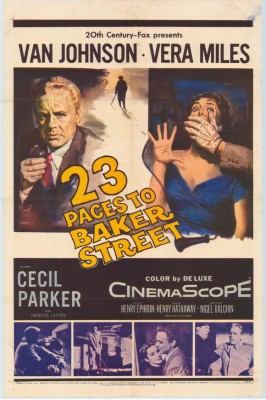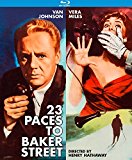| Reviews & Columns |
|
Reviews DVD TV on DVD Blu-ray 4K UHD International DVDs In Theaters Reviews by Studio Video Games Features Collector Series DVDs Easter Egg Database Interviews DVD Talk Radio Feature Articles Columns Anime Talk DVD Savant Horror DVDs The M.O.D. Squad Art House HD Talk Silent DVD
|
DVD Talk Forum |
|
|
| Resources |
|
DVD Price Search Customer Service #'s RCE Info Links |
|
Columns
|
|
|
23 Paces to Baker Street
Better still, Kino's new Blu-ray utilizes an excellent transfer that's razor-sharp and reproduces the wonderfully booming four-track magnetic stereo audio.
Adapted from the novel by Philip MacDonald, the picture stars Van Johnson as Philip Hannon, a playwright bitterly coping with his recent blindness. In London with a successful West End show, he lives in a large flat along the Thames, and aided by butler Mathews (Cecil Parker).
Venturing to a nearby pub, Philip overhears a conversation between a man and a woman (never clearly seen by the movie audience) suggesting they're planning to kidnap a child seven days hence. Philip rushes back to his flat to commit the overheard conversation word-for-word from memory to the reel-to-reel tape recorder his uses for his work. He immediately contacts the police and plays for them the tape, but Inspector Grovening (Maurice Denham) is dubious about the alleged impending crime, believing Philip's imaginative mind (and blindness) have got the better of him. In any case, the recorded conversation offers few clues.
Philip's former secretary and ex-fiancée, Jean (Vera Miles), shows up unexpectedly, hoping to help restore Philip's mental health. Instead she, Philip and Mathews, aware of the police's disinterest, decide to investigate the plot themselves, finding clues that eventually have them desperately searching for Janet Murch, former nursemaid to Lady Syrett's (Isobel Elsom) grandchildren.
Directed by Henry Hathaway, 23 Paces to Baker Street, like most CinemaScope productions of the era, was attempting to lure dwindling movie audiences away from their television sets and back into theaters with then-exotic locales, in this instance travelogue-like views of mid-‘50s London. More apparent with each passing year, movies like 23 Paces offer the unexpected benefit of seeing, in glorious CinemaScope and DeLuxe Color, no less, an early postwar Britain with hardly any traffic, no American fast-food and coffee shops, and even a few bombed-out buildings left over from the war.
Most of the film's interiors were actually shot on soundstages at the Fox lot in (then) Beverly Hills, but one long sequence with Cecil Parker and Patricia Laffan (the Devil-Girl from Mars herself!) was filmed all over Barkers of Kensington, an 1870 department store continuously remodeled through the years, with much Art Deco dating from the 1930s, including an impressive escalator system. It's used in the film to very good effect.
Shooting interiors in Hollywood with location shooting, frequently limited to second unit work only, using doubles, often produced unconvincing results (Hitchcock's Dial M for Murder, made three years before and similarly set in London, is an example of this done rather badly). However, the integration of Hollywood-shot footage with filmed-in-London footage in 23 Paces is very nearly seamless. The stars appear prominently in the London-shot footage, while the British actors varied from primarily American-based expats like Estelle Winwood (as a barmaid) to actors like prolific character actor Denham, who almost never worked outside of England.
Van Johnson is credible as the blind, bitter playwright, who'd rather convince strangers that he is sighted than submit to their offers of sympathy. Deliberately paced, the 103-minute film builds methodically to a genuinely suspenseful third act, though the limitations of the CinemaScope format work against the Wait Until Dark-like climax as much as its advantages help to show off London. Director of Photography Milton R. Krasner uses all the real estate the 2.55:1 format offers.
The picture even offers a couple of genuine surprises toward the end, including a big revelation that caught this reviewer completely off-guard.
Video & Audio
Incredibly, Fox's previous home video release, a Fox Cinema Archives DVD from 2013, utilized a grainy, ages-old and totally unacceptable panned-and-scanned video master that was thoroughly unwatchable. By contrast the Blu-ray positively sparkles. With its pleasing film grain, the image and color are stronger than one usually expects for a 1956 CinemaScope title, and the transfer all by itself makes this a Blu worth getting, even if the movie weren't as good as it is. The DTS-HD Master Audio replicates the four-track mag experience nicely, sending some music and discrete audio to the surround speakers at key moments. Region A encoded and optional English subtitles are offered.
Extra Features
Supplements include an audio commentary track by Kent Jones and a trailer.
Parting Thoughts
A pleasant surprise, 23 Paces to Baker Street is Highly Recommended.
Stuart Galbraith IV is the Kyoto-based film historian largely absent from reviewing these days while he restores a 200-year-old Japanese farmhouse.
|
| Popular Reviews |
| Sponsored Links |
|
|
| Sponsored Links |
|
|
| Release List | Reviews | Shop | Newsletter | Forum | DVD Giveaways | Blu-Ray | Advertise |
|
Copyright 2024 DVDTalk.com All Rights Reserved. Legal Info, Privacy Policy, Terms of Use,
Manage Preferences,
Your Privacy Choices | |||||||















